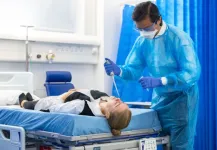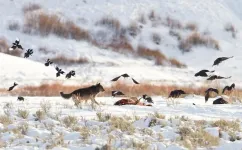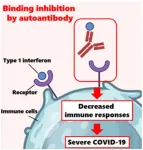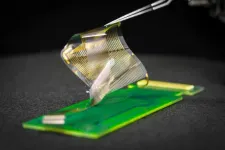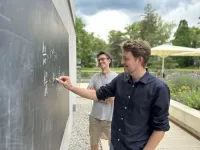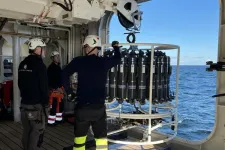Scientists have discovered novel immune responses that help explain how some individuals avoid getting COVID-19.
Using single-cell sequencing, researchers from the Wellcome Sanger Institute, University College London (UCL), Imperial College London, the Netherlands Cancer Institute and their collaborators, studied immune responses against SARS-CoV-2 infection in healthy adult volunteers, as part of the world's first COVID-19 human challenge study1. Not all exposed participants went on to develop a COVID-19 infection, allowing the team to uncover unique immune responses associated with resisting sustained viral infection and disease.
The findings, published today (19 June) in Nature, provide the most comprehensive timeline to date of how the body responds to SARS-CoV-2 exposure, or any infectious disease. The work is part of the Human Cell Atlas initiative to map every cell type in the human body2.
Severe acute respiratory syndrome coronavirus 2 (SARS-CoV-2) has infected millions across the globe with Coronavirus disease 2019 (COVID-19). While it is potentially fatal, many will have come into contact with someone who has tested positive for COVID-19, but have managed to avoid getting ill themselves, whether remaining negative on PCR testing or having an asymptomatic case of the disease.
While previous studies have examined COVID-19 patients after symptom onset, in this new study researchers set out to capture immune responses right from exposure, in an immunologically naïve cohort for the first time.
As part of the UK COVID-19 Human Challenge study, led by Imperial College London, 36 healthy adult volunteers without previous history of COVID-19 were administered SARS-CoV-2 virus through the nose. Researchers performed detailed monitoring in the blood and lining of their noses, tracking the entire infection as well as the immune cell activity prior to the infection event itself for 16 volunteers. The teams at the Wellcome Sanger Institute and UCL then used single-cell sequencing to generate a dataset of over 600,000 individual cells.
Across all participants, the team discovered previously unreported responses involved in immediate virus detection. This included activation of specialised mucosal immune cells in the blood and a reduction in inflammatory white blood cells that normally engulf and destroy pathogens.
Individuals who immediately cleared the virus3 did not show a typical widespread immune response but instead mounted subtle, never-seen-before innate immune responses. Researchers suggest high levels of activity of a gene called HLA-DQA2 before exposure also helped people prevent a sustained infection from taking hold. In contrast, the six individuals who developed a sustained SARS-CoV-2 infection exhibited a rapid immune response in the blood but a slower immune response in the nose, allowing the virus to establish itself there.
The researchers further identified common patterns among activated T cell receptors, which recognise and bind to virus-infected cells. This offers insights into immune cell communication and potential for developing targeted T cell therapies against not just COVID-19, but other diseases.
Dr Rik Lindeboom, co-first author of the study, now at the Netherlands Cancer Institute, said: “This was an incredibly unique opportunity to see what immune responses look like when encountering a new pathogen – in adults with no prior history of COVID-19, in a setting where factors such as time of infection and comorbidities could be controlled.”
Dr Marko Nikolić, senior author of the study at UCL and honorary consultant in respiratory medicine, said: “These findings shed new light on the crucial early events that either allow the virus to take hold or rapidly clear it before symptoms develop. We now have a much greater understanding of the full range of immune responses, which could provide a basis for developing potential treatments and vaccines that mimic these natural protective responses.”
Dr Sarah Teichmann, senior author of the study and co-founder of the Human Cell Atlas, formerly at the Wellcome Sanger Institute, and now based at the Cambridge Stem Cell Institute, University of Cambridge, said: “As we’re building the Human Cell Atlas we can better identify which of our cells are critical for fighting infections and understand why different people respond to coronavirus in varied ways. Future studies can compare with our reference dataset to understand how a normal immune response to a new pathogen compares to a vaccine-induced immune response.”
Shobana Balasingam, research lead in Wellcome's Infectious Disease team, said: “Human challenge models are an invaluable way to build our understanding of how the body responds to infectious disease. These studies enable us to closely monitor what happens from the moment of infection by allowing us to follow the immune response through to the development and severity of symptoms. These results are an exciting addition to our evidence-base of how different people might respond to, or be protected against, COVID-19 infections. We need to understand how factors like natural exposure to the disease affect the body’s response to the virus or a vaccine. Therefore it is crucial studies like this expand to low-resource settings where diseases are endemic, to ensure we are developing context-specific tools and therapeutics that work for those most vulnerable.”
ENDS
Contact details:
Emily Mobley
Press Office
Wellcome Sanger Institute
Cambridge, CB10 1SA
Email: press.office@sanger.ac.uk
Notes to Editors:
Human challenge studies involve deliberate human infection ‘challenge’ of a small number of low-risk volunteers (healthy, young adults) under highly controlled settings. The Human COVID-19 Challenge study, pioneered by the government task force, Imperial College London, Royal Free London NHS Foundation Trust enrolled participants from June to August 2021. For more information about the COVID-19 Human Challenge Study, please refer to the publication. The full list of inclusion and exclusion criteria and for further details regarding the challenge set up and ethics can be found at https://www.nature.com/articles/s41591-022-01780-9
This study is part of the Human Cell Atlas (HCA), an international collaborative consortium which is creating comprehensive reference maps of all human cells — the fundamental units of life — as a basis for understanding human health and for diagnosing, monitoring, and treating disease. The HCA is likely to impact every aspect of biology and medicine, propelling translational discoveries and applications and ultimately leading to a new era of precision medicine.
The HCA was co-founded in 2016 by Dr Sarah Teichmann, then at the Wellcome Sanger Institute (UK) and Dr Aviv Regev, then at the Broad Institute of MIT and Harvard (USA). A truly global initiative, there are now more than 3,400 HCA members, from 101 countries around the world. https://www.humancellatlas.org
An abortive infection occurs when the body manages to prevent the onset of viral spread despite being exposed to the virus, defined in the study by all negative RT-qPCR results. The study further identified a new group of infection ‘intermediates,’ where low levels of the virus were detected. In these cases, a transient infection occurs, involving a brief period where the virus is present and partially replicates but fails to establish a significant infection or cause noticeable symptoms. In this intermediate group, they observed an immediate immune response in the nose that likely prevented the onset of a sustained infection. END
